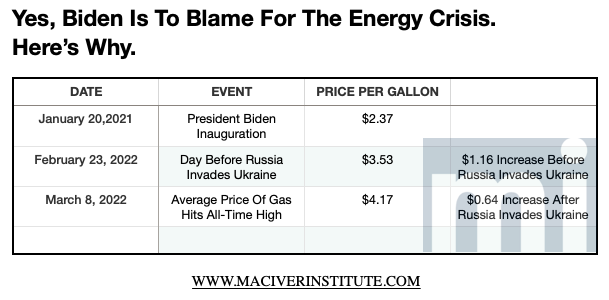Unless you’ve been under a rock for the last 16 months, you are well aware of the inflationary pressure Americans are feeling across almost every area of their lives. For a recap:
- The annual inflation rate in the US accelerated to 8.5% in March of 2022, up from 7.9% in February, and the highest since December 1981.
- Comparing March 2022 to February 2022:
- Energy prices increased 32%, namely gasoline (+48%) and fuel oil (+70.1%).
- Food prices jumped 8.8%, the most since May 1981.
- Inflation accelerated for shelter (+5% vs 4.7% in February) and new vehicles (+12.5% vs 12.4%) but eased for used cars and trucks (+35.3% vs 41.2%).
- Excluding volatile energy and food categories, the CPI rose 6.5%, the most in 40 years.
- The producer price index (PPI) also is rising at an alarming rate, +1.4% in March and +11.2% vs. year-ago (YAG).
A Failed Narrative on Energy
One of the talking points the Biden administration loves to regurgitate is that energy inflation is all due to the Russian invasion of Ukraine. It’s a complete propaganda narrative lie.
- During the presidential campaign, Biden made it clear he would cut the oil and gas industry. In his own words: “Number one, no more subsidies for fossil fuel industry. No more drilling on federal lands. No more drilling, including offshore. No ability for the oil industry to continue to drill, period, ends, number one.”
- Why would Biden do this? It starts with the globalist movement toward renewable energy, and continues with the failed “Green New Deal.” The Green New Deal was such a poorly conceived plan that it faced no chance of passing legislative approval, so Biden and the liberal left simply side-stepped the legislative process and purposely hamstrung the oil and gas industry in favor of renewables. Isn’t it ironic how the Biden administration wants to shut down oil, gas and coal production in the U.S., but is fine with China, Russia and the Middle East producing more? Does global warming not apply to those countries?
- Not surprisingly, when Biden was elected, the price of crude oil began to rise, as oil futures take into consideration multiple factors including geo-political and leadership uncertainty, and given Biden’s stance on energy, supply was going to be constrained vs. demand…driving up prices.
- Shortly after taking office, Biden signed an executive order cancelling the Keystone pipeline, further placing uncertainty around the oil and gas supply in North America, and driving prices higher and forcing 10’s of thousands of people into unemployment.
- Biden and his administration are holding up oil & gas lease approvals. Thousands of lease proposals have been stalled by his bureaucracy.
- Watching gas prices explode, Biden turned to OPEC and begged them to increase oil production to try and reduce energy costs (as opposed to increasing domestic investment). Not surprisingly, that ask fell on deaf ears, as OPEC is enjoying high prices due to one of the world’s biggest suppliers, the United States, being purposely hamstrung by Biden’s failed policies.
- While Biden was only too eager to shut down domestic oil/gas production he did not take action to shut down the Nord Stream 2 pipeline from Russia to Europe. That meant Europe, already heavily dependent on oil and gas from Ukraine & Russia, would now even be further dependent on Russian supply.
- So, what does all this mean? From the time Biden took office, gas prices skyrocketed by almost $1.20/gallon, or ~ 50% even before Russia invaded Ukraine.


Bad Policy Leads to Worse Decisions
With energy costs hurting consumers, inflationary pressures mounting, and the Biden administration doing everything possible to continue a relentless shift away from fossil fuels with no substantive or realistic approach to transitioning from fossil fuel to renewable energy, they are following a failed strategy playing out in Europe right now. Renewable energy accounts for almost 40% of Europe’s energy needs, with wind and hydroelectricity accounting for 2/3’s of renewables. Nuclear energy accounts for almost 25%, but Europe is not investing in new nuclear plants, which is interesting given their only emissions are heat & water. On the fossil fuel side, 40% of the gas Europeans burn and over 25% of the crude oil come to Europe from Russia, which means Europe is beholden to an aggressive, socialist dictator to power the EU economy. If you’re wondering why Europe is not being more aggressive against Russia’s invasion of Ukraine, now you know why.
With the United States levying sections on Russia in retaliation for their invasion of Ukraine, you would think the U.S. would no longer import any oil from Russia. You would be wrong. In fact, the U.S., a country that was net energy positive (greater exporter than importer) in 2019 & 2020, is importing about 3% of oil needs from Russia, or around 600K barrels per day, indirectly funding a war against Ukraine. So, in a blatant demonstration of hypocrisy, the United States government recently approved $13.6 billion in aid for Ukraine to fight Russia, but continues to purchase 600K barrels of oil per day from Russia.
E15 to the Rescue?
In the last week, Biden announced his brilliant plan to help reduce the pain at the pump: More Ethanol. Most of the fuel we buy today has 10% ethanol, which is a corn or seed-based alcohol added to the blended gasoline. Originally conceived to be a more “green” fuel, ethanol is nothing of the sort. In fact, a recent analysis postulated ethanol provides absolutely no help in reducing greenhouse gases, and only further exacerbates poor land usage while raising food prices of corn-based products. So, how this decision fits with the plan to move away from fossil fuels due to emissions, when ethanol could actually be worse, is a mystery. But wait, there’s more.
Part of Biden’s plan is to work with the EPA to issue a waiver to enable the sale of E15 (15% ethanol), so that seed-based alcohol could take the place of the lower supply of blended gasoline. Why would a wavier be needed? E15 is illegal to sell during the summer months (June – September) because it is a higher-polluting fuel during hot temperatures. That means we’re introducing a more polluting fuel in lieu of gasoline, just as we come into the summer season, where miles driven are typically at their highest. But wait, there’s more.
E15 fuel dispensing has specific requirements, which means there are only 2,300 stations across the United States that can safely sell E15. According to the NACS, there are approximately 145,000 filling stations across the United States. So, if you’re counting at home, this means E15 could be offered in 1.6% of the total filling stations across the U.S, hardly a drop in the total bucket of fuel stations and meaningless in any ability to lower gas prices. But wait, there’s more.
Ethanol has been shown to cause numerous problems in engines. Ethanol is hygroscopic, which means it absorbs moisture from the air, causing the fuel blend to separate. Having worked in the automotive aftermarket for some time, we saw numerous problems with ethanol related to corrosion of metal parts, gumming or gelling of critical components, wearing and degradation of seals, incorrect fuel readings that cause check engine lights, and poor cold temperature and starting performance. An engine that uses ethanol (say, E85) has to be built to handle the different fuel, or catastrophic damage can occur. So, sure, why not add more of a fuel that can cause more problems in engines (unless you are purposely trying to move people toward EV’s…). But wait, there’s more.
Elon Musk, CEO of Tesla and one of the more visionary leaders in the corporate world today, has gone on record saying we need to continue to invest in oil and gas to achieve energy independence. While that would potentially hurt his company (Tesla manufacturers 100% EV’s), he understands that energy independence is vital to national security, geopolitical stability and countering inflation. But wait, there’s more.
In the wake of 2017’s Hurricane Harvey, which devastated the gulf coast and strangled oil and gas production due to extreme damage & flooding, President Trump lifted the limit on E15 for temporary relief in the wake of severe supply problems, which lasted for a few months. However, a second call to lift the limit more permanently on E15 two years later was struck down by a Federal Appeals Court. So, Biden’s own failed policies are akin to a self-imposed natural disaster in the effect on the oil & gas industry.
We’ve Had Enough
If you’re keeping track, by now it’s pretty obvious the high gas prices, high energy prices, high inflation, high PPI and economic strains on the American consumer are not due to Russia’s invasion of Ukraine, but due to the Biden administration’s terrible policies and even poorer tactical decisions that not only are hypocritical, but stand to only cause more problems in the near future.
Leaders must have a sound moral compass and make decisions based on a clear and consistent, fact-based, and strategically clear thought process. While we have seen ample examples of decisions from Biden’s administration that are nothing of that sort, the current hypocrisy around inflation, energy and ecology is a great example of bad policy driving bad decisions to a whole new level.
